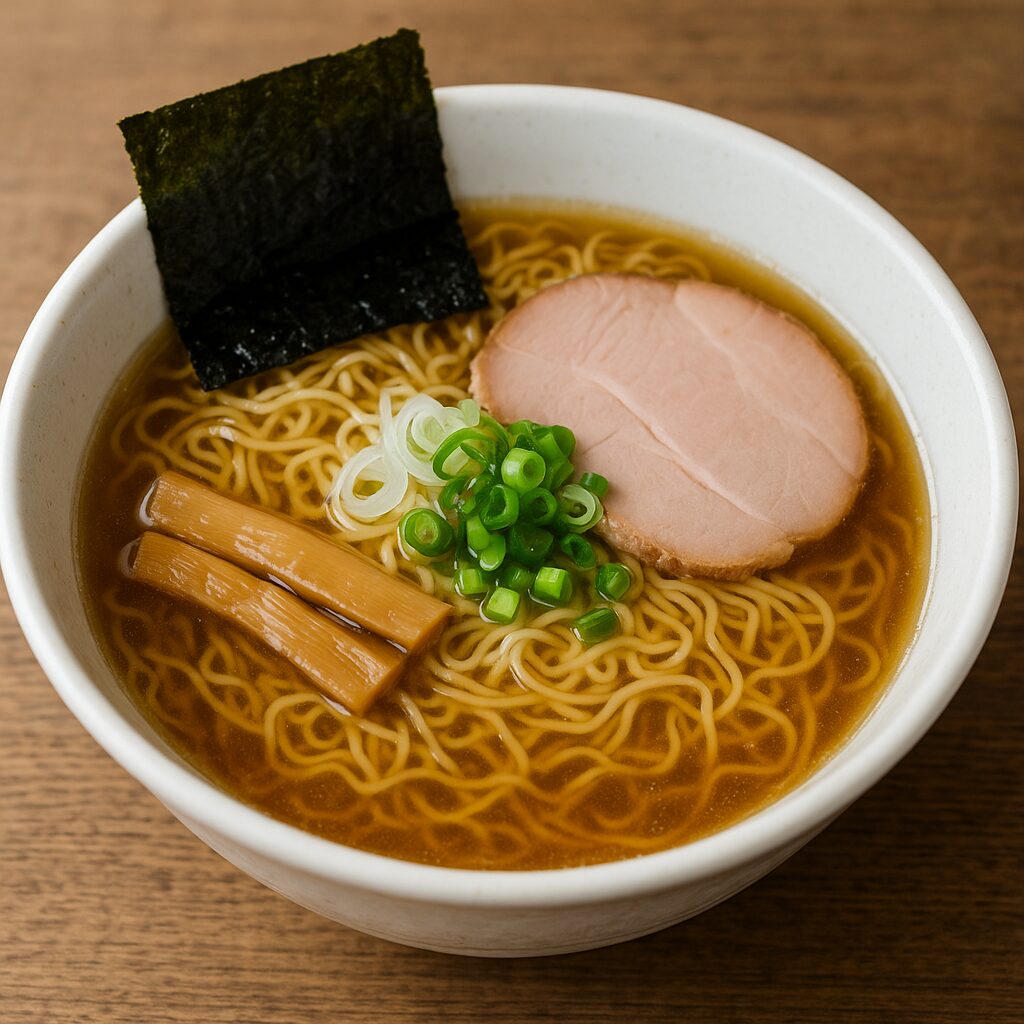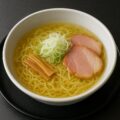釧路ラーメンの特徴
あっさりとした醤油スープ
釧路ラーメンは、鰹節をベースに鶏ガラや煮干し、昆布などを加えたあっさりとした醤油味のスープが特徴です。透明感のあるスープで、毎日でも食べやすい軽さがあります。
極細縮れ麺
釧路ラーメンは、ラーメンの中でも特に細い極細縮れ麺を使用します。低加水でスープをよく吸い、伸びやすいため素早く食べるのが定番です。
シンプルな具材
チャーシュー、メンマ、ネギ、海苔といった基本的な具材が中心で、素朴で飽きのこない味わいです。
釧路ラーメンのレシピ
材料(2人分)
- 極細縮れ麺 … 2玉
- 鶏ガラスープ … 500ml
- 煮干し出汁 … 200ml
- 昆布出汁 … 200ml
- 醤油 … 大さじ3
- みりん … 大さじ1
- ラード … 小さじ2
- チャーシュー・メンマ・ネギ・海苔 … 適量
作り方
- 丼に醤油とみりんを合わせてタレを作る。
- 鶏ガラ・煮干し・昆布のスープを合わせ、熱々にする。
- タレにスープを注ぎ、ラードを加える。
- 極細麺を素早く茹でて丼に盛る。
- 具材をのせて完成。
塩気が足りない時は白だしを使って鰹節の風味を際立てると良いかも知れません。ラードが無い場合には鶏油で代用可能です。
釧路ラーメンの栄養価(1人分の目安)
- エネルギー:約450〜550 kcal
- たんぱく質:15〜20 g
- 脂質:10〜15 g
- 炭水化物:70〜80 g
- ビタミンB群:代謝に寄与
- ミネラル:カルシウム・マグネシウムを含む
比較的あっさりしており、カロリーも他の北海道ラーメンに比べて低めです。
釧路ラーメンの歴史
戦後の大衆食として普及
釧路ラーメンは戦後間もない1940〜50年代に広まり、庶民的な価格で親しまれてきました。
漁師町ならではのラーメン
漁師や港町で働く人々にとって、あっさりと食べやすく、素早く提供できるラーメンが重宝されました。
ご当地ラーメンとして定着
現在では北海道四大ラーメンの一つとされ、観光客にも人気のご当地グルメになっています。
English Version
Features of Kushiro Ramen
Light Soy Sauce Broth
Kushiro ramen features a light soy sauce broth based on bonito flakes, combined with chicken bones, dried sardines, and kombu. It is clear, refreshing, and easy to enjoy daily.
Ultra-Thin Curly Noodles
It uses some of the thinnest curly noodles among ramen varieties. With low water content, they absorb the broth quickly and are best eaten promptly.
Simple Toppings
Common toppings include chashu, menma, green onions, and nori, offering a simple and classic taste.
Recipe
Ingredients (for 2 servings)
- Ultra-thin curly noodles … 2 servings
- Chicken broth … 500ml
- Bonito stock … 200ml
- Dried sardine stock … 200ml
- Kombu stock … 100ml
- Soy sauce … 3 tbsp
- Mirin … 1 tbsp
- Lard … 2 tsp
- Chashu, menma, green onions, nori … to taste
Instructions
- Make the tare by combining soy sauce and mirin in a bowl.
- Mix chicken, bonito, sardine, and kombu broths, then heat thoroughly.
- Pour the hot broth into the bowl with tare, add lard.
- Cook the noodles quickly and place in the bowl.
- Top with chashu, menma, green onions, and nori.
Nutritional Value (per serving, approx.)
- Calories: 450–550 kcal
- Protein: 15–20 g
- Fat: 10–15 g
- Carbohydrates: 70–80 g
- B vitamins: support metabolism
- Minerals: calcium, magnesium
Lighter than other Hokkaido ramen varieties, making it relatively lower in calories and easier to eat.
Historical Background
Postwar Popularity
Kushiro ramen spread in the 1940s–50s as an affordable meal for the public.
Ramen of a Fishing Town
Designed to be light and quickly served, it was ideal for fishermen and port workers in Kushiro.
Local Specialty
Today, it is recognized as one of Hokkaido’s “Big Four Ramen” and remains a popular specialty among tourists.



何でも質問してください!